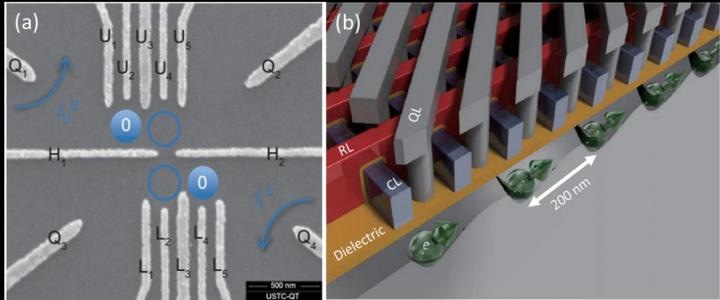Mar 22 2019
In the last few decades, quantum computing, together with 5G and AI, has been the center of attention for the next-generation technology. To date, several physical systems—such as trapped ions, superconducting Josephson junctions, and semiconductors—have been analyzed to develop a test device for quantum computing.
 Semiconductor quantum devices. A: A scanning eletron microscope of the semiconductor quantum device containing two charge qubits. B: A three-dimensional model of a design for scalable fault-tolerant quantum computing based on spin qubits in semiconductor quantum dots. (Image credit: Science China Press)
Semiconductor quantum devices. A: A scanning eletron microscope of the semiconductor quantum device containing two charge qubits. B: A three-dimensional model of a design for scalable fault-tolerant quantum computing based on spin qubits in semiconductor quantum dots. (Image credit: Science China Press)
Of all these, semiconductors stand apart due to their high control fidelity and potential for integration with classical CMOS technology. Professor Guo-Ping Guo with his colleagues, Xin Zhang and Hai-Ou Li from the Key Laboratory of Quantum Information, Chinese Academy of Sciences, University of Science and Technology of China, examine the latest advancements of qubits based on semiconductors and debated over the difficulties faced by and opportunities for scalable quantum computing. This study, titled “Semiconductor quantum computation,” was published in National Science Review.
Quantum bit, or qubit, is similar to the classical bit and is the basic unit of a quantum processor. Based on the life cycle of a qubit technology, the standard qubit progression can be roughly divided into six stages—starting from the demonstration of single- and two-qubit control and measurement of coherence time (Stage I), and moving to the benchmarking of readout fidelity and control of 3 to 10 qubits (Stage II). Using these advancements, it is possible to demonstrate specific error correction of certain physical qubits (Stage III), and following that, a logical qubit formed from error correction of physical qubits (Stage IV) and corresponding complex control must be completed (Stage V).
Lastly, a scalable quantum computer formed of such logical qubits is developed for fault-tolerant computing (Stage VI). In semiconductor quantum computing, there exist different types of qubits such as charge qubits, spin qubits, exchange-only qubits, singlet-triplet qubits, hybrid qubits, and so on. Of all these, control of single- and two-qubit gates was shown for charge qubits, spin qubits, and singlet-triplet qubits, indicating that they have completed stage I and the on-going studies demonstrate that stage II will also be finished soon.
To date, benchmarking of single- and two-qubit control fidelity close to the fault-tolerant threshold was exhibited and scaling up to three or more qubits would be essential in the future. One such device was developed by Guo guoping’s team at the University of Science and Technology of China for coherent control of the interaction between two charge qubit states.
To realize further advancements, there still exist certain challenges to overcome. In this study, the researchers present three important problems as more reliable and effective readout techniques, stable and uniform materials, and scalable designs. Strategies to solve these problems have been analyzed by several research groups, including using microwave photons for the detection of spin or charge states and employing purified silicon as an alternative to gallium arsenide for spin control.
The scalable designs with the approach for wiring control lines and readout lines were also presented, and in these strategies, the operation time and geometry constraints, engineering configuration for the quantum-classical interface, and applicability for various fault-tolerant codes to execute logical qubits were also discussed. In 2018, an example of such a design was put forward by Li et al. at Delft University of Technology. In a device such as that, the crossbar arrangement of electrodes has the ability to form an array of electrons in silicon, and it is possible to control their spin states by microwave bursts.
With the ongoing debates for noisy intermediate-scale quantum technology (NISQ), proposing that a quantum computer with 50–100 qubits and lower circuit depth that can outperform the potentials of existing classical computers will be available any time soon, the researchers predicted that to be a new candidate to compete in the scalable quantum computing field with trapped ions and superconducting circuits, semiconductor quantum devices can also achieve this technical level in the years to come.
This study was supported by the National Key Research and Development Program of China, the National Natural Science Foundation of China, the Strategic Priority Research Program of the Chinese Academy of Sciences, and the Anhui initiative in quantum information technologies.